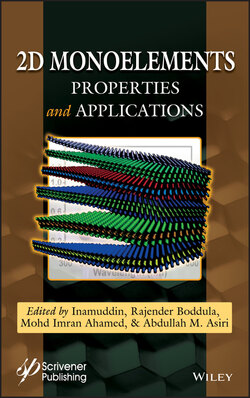Читать книгу 2D Monoelements - Группа авторов - Страница 54
2.4.5 Biomedicine
ОглавлениеDue to the excellent optical, electronic, optoelectronic, physical, and chemical properties, antimonene can be well used in biomedicines, such as photothermal therapy (PTT), photodynamic therapy (PDT), photoacoustic imaging (PAI), photonic drug-delivery platform, and biosensor, etc. [60].
Superior photothermal performance and biocompatibility enable antimonene to be employed as effective photothermal agents (PTAs) for cancer therapy. Tao et al. synthesized highly-dispersed 2D antimonene quantum dots (AMQDs) by the LPE and explored their ability of PTT as novel PTAs [61]. To enhance the biocompatibility and stability of AMQDs in physiological medium, 1,2-Distearoyl-sn-glycero-3-phosphoethanolamine-N-[methoxy(poly ethylene glycol)] (DSPE-PEG) was then modified on their surface. From the photothermal heating curves shown in Figure 2.11a, PEG-modified AMQDs exhibited a concentration-dependent photothermal effect with temperature increment as high as 50°C. The obtained photothermal conversion efficacy (PTCE) (η) was 45.5%, which was higher than most of nanomaterials-based PTAs. The near-infrared (NIR) induced degradation of PEG-modified AMQDs in water was very rapid with only several minutes; this feature was superior to that of BP. Both in vitro and in vivo therapeutic studies, PEG-modified AMQDs showed potential biocompatibility. When combined with NIR irradiation, PEG-modified AMQDs achieved effective killing of cancer cells and complete ablation of tumors by PTT (Figure 2.11b). In another work, antimonene nanoparticles (~55 nm) cloaked with cell membrane (CmNPs) was used as PTAs in PTT and PDT for high-performance cancer theranostics, benefiting from the enhanced permeability and retention (EPR) effect, superior stability, and good tumor targeting capacity [62]. In vitro phototherapy, the viability of 4T1 cells in the CmNP group was lower than that in the antimonene nanoparticle (mNP) group. Upon NIR irradiation, the 1O2 generation and the dead cells were more in the CmNPs group, confirming an effective phototherapy effect. In vivo phototherapy, the temperature in the CmNP group (57.1°C) was higher than that in the mNP group (48.3°C). The 1O2 signal was brighter and the tumor was completely inhibited with few abnormalities in the CmNP group under NIR irradiation, again confirming the superior theranostic performance.
Figure 2.11 (a) Time-dependent photothermal heating curves of PEG-modified AMQDs with different concentrations under irradiation of NIR laser (808 nm, 2 Wcm−2). (b) Relative tumor volumes after treatment with saline (G1), NIR (G2), PEG-modified AMQDs (G3), PEG-coated AMQDs +NIR (G4). (c) Intracellular PA signal versus time. (d) Photoacoustic tomography (PAT) images of tumor at various time points after injection of BSA-AMNFs. (e) DOX concentration-dependent loading capacities on AM-PEG NSs. (f) In vitro release profiles of DOX from AM-PEG/DOX NSs under different treatments (pH and pH+NIR). (g) The SPR angle change versus miRNA concentration of ssDNA-AuNRs and ssDNA. (h) Comparison of the LOD of antimonene-based SPR sensor with other reported miRNA sensors. (a, b) Reproduced with permission [61]. Copyright 2017, Wiley-VCH. (c, d) Reproduced with permission [63]. Copyright 2019, Wiley-VCH. (e, f) Reproduced with permission [64]. Copyright 2018, Wiley-VCH. (g, h) Reproduced with permission [65]. Copyright 2019, Nature Publishing Group.
Furthermore, LPE-produced antimonene nanoflakes (AMNFs) were used as ideal contrast agents for PAI, due to the excellent photoacoustic (PA) performance [63]. AMNFs showed high molar extinction coefficient of 2.24 × 109 in the NIR window (800 nm), high photothermal conversion capability with temperature increment up to 207.9°C after 30 min NIR irradiation, and high PTCE of 42.36%, indicating superior performance of AMNFs to other widely used PAI contrast agents, such as organic small molecule dyes, gold nanomaterials. AMNFs also exhibited a dose-dependent and wavelength-independent PA signal with the lowest detection limit of 0.6986 μg mL−1. Besides, the low thermal conductivity (15.1 Wm−1K−1) and high interfacial thermal conductivity of AMNFs resulted in a stronger PA signal. The photon emission was absent in AMNFs, ensuring the maximum photothermal conversion. To increase the biocompatibility, bovine serum albumin (BSA) was coated on the surface of AMNFs. The above excellent PA performance of BSA-AMNFs allowed sensitively monitoring the cellular uptake process in vitro and clearly imaging the small volume tumor in vivo (Figures 2.11c, d).
Tao et al. adopted PEG-modified antimonene (AM-PEG) nanosheets (NSs) as a robust photonic drug-delivery platform for multimodal-imaging-guided cancer theranostics [64]. AM-PEG NSs first showed considerable PTCE of 41.8% and high loading capacity of doxorubicin (DOX) molecules with the largest value of 150% (Figure 2.11e). Then, the release of DOX molecules presented both pH-sensitive and NIR-sensitive characteristics, which enabled the platform to be designed simpler (Figure 2.11f). In vitro, AM-PEG/DOX NSs exhibited photo-induced deep penetrating ability into tumor spheroids and enhanced intracellular uptake. Therefore, combined with NIR irradiation, AM-PEG/DOX NSs killed almost all the tumor cells, indicating an efficient therapeutic effect. In vivo, AM-PEG/DOX NSs continued to accumulate and retain in the tumor sites, then completely eliminated the tumors and inhibited their growth, attributing to a synergistic effect of PTT and chemotherapy. With good biocompatibility and potential degradability, AM-PEG NSs were very promising drug-delivery platform for cancer theranostics.
Having more delocalized 5s/5p orbitals, antimonene can interact strongly with single-stranded DNA (ssDNA), allowing for ultrasensitive detection of cancer-associated MicroRNA (miRNA) molecules. Xue et al. developed an antimonene-based surface plasmon resonance (SPR) sensor and performed trace attomolar-level quantitative detection of miRNA-21 and miRNA-155 [65]. Benefiting from the signal amplification of gold nanorods (AuNRs), this antimonene-based SPR biosensor showed an extremely low limit of detection (LOD) of 10 aM to miRNA-21, which was the highest sensitivity comparing to other reported miRNA sensors (Figures 2.11g, h).
